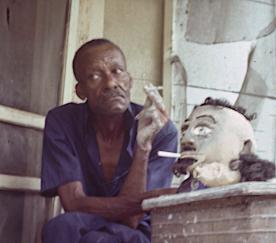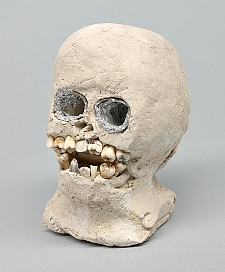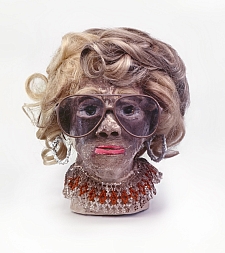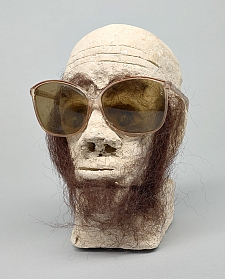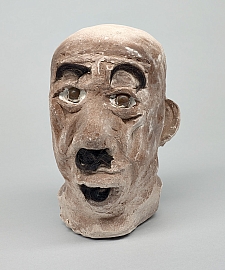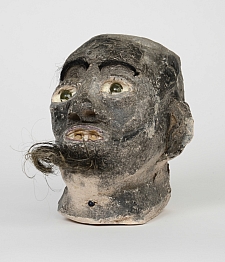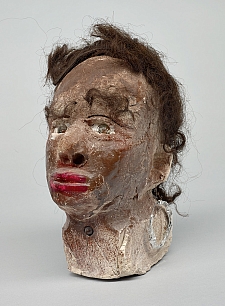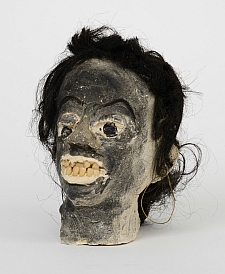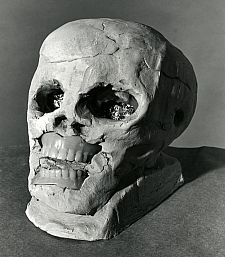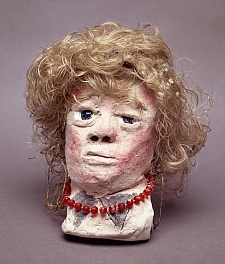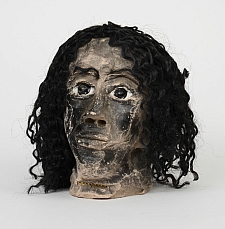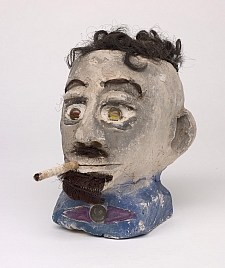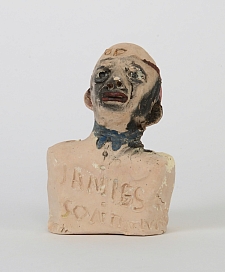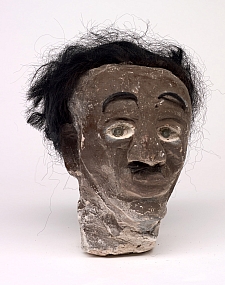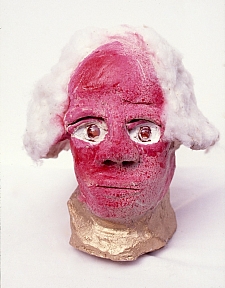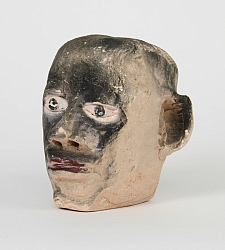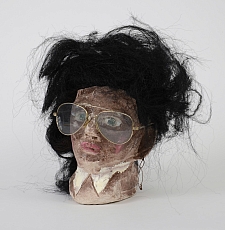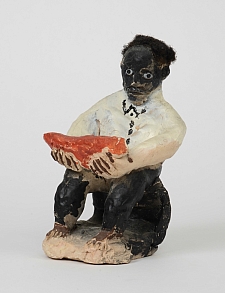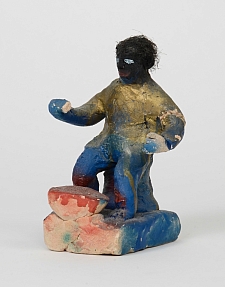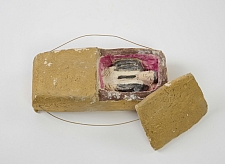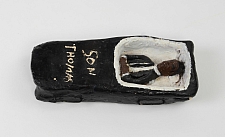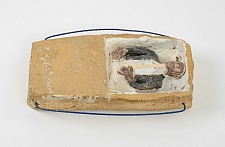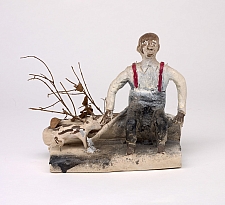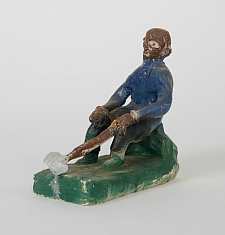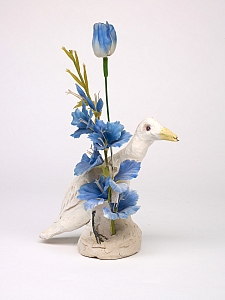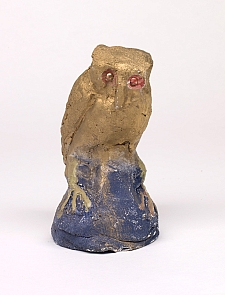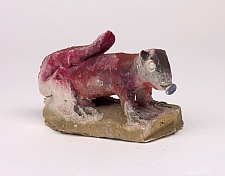James 'Son Ford' Thomas
About
Back where I live in Yazoo County they wouldn’t hardly know who you was talking about if you’d go over there and ask for James Henry Thomas. But if you say “Son Ford” they would know because they give me that name when I was going to school. I used to make little Ford tractors out of clay. I’d put me some sticks through there [as axles] and make me some wheels and let it dry and then I’d have something to roll across the floor. That was back in 1937 when they first started calling me “Thirty-seven Ford,” and then they started calling me just regular “Ford” from then on. So I said if I ever record records, I’d have it put in, “Sonny Ford.”
That’s so all my friends would know who I was. This is all done by head, not by no book or no picture. I have never went to school to do this. No teacher has ever taught me nothing about it. My Uncle Joe was the first person that showed me. He started me off molding. But he never did make nothing but little mules and stuff like that. If my uncle had kept on he probably could do as good as me. But now I doubt whether he could make anything. He didn’t know what there was to it. After he quit, then I taken that trade up. I tried the same thing that he tried and I done pretty good on it, so I took it over. It wasn’t too hard for me to catch on. I just kept on trying until I got perfect on it. A lot of days I would be by myself and I’d walk two or three miles to get me some clay and I’d come back home and sit up by the fireplace at night and make things until I got sleepy. I got where I could make mules, and rabbits, and squirrels, and things like that, and from that I went to making birds. See, this is a quail I made here. In Mississippi the white people didn’t want the colored people to eat no quail. See, they had more meat than other birds better meat. So I don’t care if you had a license for hunting, you couldn’t kill no quail and let it be known. You could kill blackbirds, but if you killed a quail, it was just like you done shot somebody. Well. I got better and better all the time on molding. The more you make, the more it’ll come to you what to do with anything.
That was when I was a little-bitty boy going to school—I’d say about six years old. That’s how I got my school money. My grandmother and granddaddy would work a whole week for two dollars, so they wasn’t able to buy none of that stuff for me. So I made this sculpturing to buy me crayons, pencils, paper, and all like that. I’d sell the things that looked good enough around the neighborhood where we lived at. And so after I got grown I liked to be doing it, and I just kept going.
The highest I ever sold when I was small, one day I sold some horses and I got three dollars for them. A fellow from Vicksburg was over at Eden and I had them horses in a box.
He said, “Where’d you get them little horses?”
I told him I made them.
He said, “I’ll give you three dollars for them.”
Well, that sounded big then, and I just handed him the whole box. So I would wind up making more than my grandmother and granddaddy and I was just sitting at the house sculpturing.
The first time I made a skull I was living with my grandpapa in Yazoo County. I made a great big skeleton head and I had corn in his mouth for teeth. I brought it in the house and set it up on the shelf. We didn’t have no electric lights then. My granddaddy was scared of dead folks, and one night he had stayed up late. He came in and lit him a match to light the lamp and, first thing, he looked in the skeleton’s face. Instead of pulling the globe off the lamp, he jumped and dropped the globe and run into my room and told me, said, “Boy, you get this thing out of my house and don’t bring another in here. I already can’t rest at night for spooks now.”
You don’t never hardly hear nobody talking about being scared of spirits now. They ain’t got time to think of it. But a long time ago there was a whole lot of people would talk of spooks. White people would use the word ghosts. They say ghosts, and not spooks. I don’t know why there’s the separation in that. But right now the average person in Leland, if you go and talk with them they’ll say, “Oh, there ain’t no such thing as a ghost.” Some don’t believe in them. But I believe in ghosts. Of course, I work for a funeral home, but I don’t never let night catch me out. I always get through before night, or either wait and finish the next day.
And a lot of colored people believe in what they call the hoodoo. Most of the white people, they don’t believe in hoodoo. But it is something. It’s got to be. You can get sick—you don’t have to be real sick—but your blood can get wrong and you can get that way where you’ll lay down and see things. People that’s low sick [deathly sick], they’ll see things sometimes. When my stepdaddy died, he used to say, “Look at them dogs. Get them dogs out of here.” Well, that’s low sick. And I got that way once. I was small and my grandmother, she’d make me sleep on this cot that we’d got from some white people. I just couldn’t rest on that cot. I’d see all kinds of men and little boys and everything coming up around that cot and hitting at me. And I heard my grandmother and them whispering and saying they believed I was going to die the way I was carrying on. So they finally got rid of that cot. And I didn’t feel that way no more. I don’t know what it was.
I moved to Leland from Eden in 1961. I’ve been here ever since. Before that I was a tractor driver for three or four years, well, longer than that, off and on. And I was always farming. After that I started working at the funeral home—working in the yard, mowing grass, and digging graves. I been opening and closing graves ever since 1961, and I always say that I got a cemetery of my own, I done dug so many graves. I used to help my stepdaddy dig graves and I got to where I liked to do it. My stepdaddy didn’t have but one arm. And he used a three-foot shovel. I used to come out and help him. He’d tell me, “Son, I believe I can beat you digging.” Even though I had two hands, it didn’t make no difference. He always beat me. So he learned me how to do it, and after he died, I taken over the job. I never did do no easy work and I thought digging graves was all right for me.
I make deers, rabbits, quails, fishes, skeleton heads, and solid heads. I make them out of gumbo clay. Some of it comes from the hills around the other side of Greenwood. It holds together just like the regular molding clay. I get some clay south of Leland, down at Black Bottom, too. The name of it really is black gumbo, but some people call it buckshot because it’s so sticky it takes a buck to run through it. It is sticky. I’ve known places where people raised chickens, and come a rain those little baby chickens they’d get stuck in that clay. It’d be all balled up under their feet.
When it rains, I let the clay soak up the water. Sometimes I mix a little wax with it to help hold it together. It cracks open real bad if you work with it like it is. Then I put hair grease on there to smooth it down and get the wrinkles out of it. Like if I make something and I don’t want to work on it any more until tomorrow, I put me some towels across there and wet towels to keep it soft. But it don’t dry out too fast. Then after I get it worked out, I put putty on it. That’s for if it happens to crack, that putty would still be holding and you couldn’t see the crack, unlessen it got real bad.
Well, I started painting them a long time ago. If I was making it for myself, I’d just paint it the first color I’d get to. It wouldn’t make me no difference. I’d use whatever I’d think would show up on there the best. You can paint them any. time. I wait until they’re dry and then paint them. Like this mallard, you paint the bill yellow, and then you would put green on the head to make it show up. Or you could paint the head and the body white. That shows up good, too. I get different colors of paint at the ten-cent store. I have gold I spray on sometimes, and beige, and white, and black. Things that show up, you know. But when I first started, I couldn’t get no paint. I would just let them dry. That hill clay, you could put it in the fireplace and bake it. In the wintertime, I’d make me a dog or something out of clay and I’d throw it in the fire and let it cook and turn red. Sometimes my granddaddy would go to put a stick of wood in there and I’d jerk it out real quick!
He’d tell me, “Keep that mess out of the fireplace. I can’t keep no wood in it.” Well, that sculpture of mine would get just like a brick and it would rattle too, you know.
When I do my sculpturing work things just roll across my mind. Like I see a picture in a magazine or on television, and that’s what I’ll go by. Sometimes I may not get it direct, but I make it as far as I can remember on it. I look at the picture and get the future of it better. The future that means if I was going to make a man that looked just like you, that would recollect you. The futures come in dreams. The dreams just come to me. I lay down and dream about the sculpture, about how to fix one of the heads, things like that. I’m liable to dream anything. That gives you in your head what to do. Then you get up and try. If you can’t hold it in your head, you can’t do it in your hand.
I make a face first, then make me a skull. First I shape it up like a regular man’s head. Then I cut it down to a skeleton head. That’s the onliest way you can get a shape. The cause of me taking the top out of the head, that’s for an ashtray. That’s about the best ashtray you can have, because you can put a whole lot of stuff in there if you make it big enough. I take both thumbs at the same time and squeeze it in to make the eyes. I put marbles in there for eyes, or like that duck,
I put match heads in there for the eyes. That’s in case you want to paint his eyes, so when it dries you can spot them. That way you’ll know the direct place where you want them at. You can just take the matches out and paint the eyes in there. The eyes should be clear and plain, just like a picture you take with a camera. There is one thing I’d like to improve on and that’s the eyes. You have to draw your eyes in there before you can get them lined up. Your eyes are on a level with your ears. They can’t be a bit higher than your ears and they can’t be no lower. They got to be the same level your ears is and that’s why you don’t have no trouble making glasses. If some people’s eyes was down below their nose, they couldn’t get no glasses to fit them. If I ever get the eyes just like I want to, I can make any kind of future.
So I go back to where I done mashed up there with the eyes, and that’s automatic the nose. Then I build up on that. I cut the nose off then, to get the holes in the direct place. I use corn for teeth because I couldn’t think of nothing else. You know the reason I started cutting the corn oft‘? Because the first one I made, I noticed the teethes came out. They would move, you know. I checked on it then, that skull I had up there at Shelby’s [Shelby "Papa Jazz” Brown],"' and that corn was sprouting in there! That’s where I decided the next one I made, I would cut that com off to where it wouldn’t sprout. Then I got another idea. If it keeps on sprouting, I decided I’d try painting them teeth in there. I’d paint them white and get me some clear varnish so they’d shine. That thought come to me not too long ago. I hadn’t never given it a try yet. But I believe I could take something and cut some teeth in there. It might do a better job. I don’t know.
A skull has got to be ugly because it’s nothing but bones and teeth. People are more likely to be interested in something like that than they would be in a bird. They’d rather see a skull. Then too, a lot of people have never seen a real skull and they’re probably wondering how it will be when they die. They say, “Will I be in the same shape that skull there is in?”
When I get it worked out, I stand back and look at it, see, to see if I have it in shape. In working close, you can’t hardly tell about how it looks. You have to get off from it and look and see what shape you got it in. You have to see if you got it too large on one side, or not large enough. Then you level it up. You stand off from it to tell what you’ve done. It’s got to be even on each side, see.
I don’t like to do my sculpturing all the time. It just hits me by spells. A spell will hit me and sometimes I can make them for half a day. Then I’ll get tired of that and be wanting to go somewhere or do something else. In the wintertime I’ll be sitting up and not doing nothing, so I’ll just sculpture a while and then quit. I don’t know what I’d make if I’d just steady at it all the time. But to do this you got to have patience. You got to feel like doing it. You can do a whole lot better when you don’t try to make too many. You just have to take your time.
If I could get to a mountain where they have this clay like I use, I believe I could do me a whole man. I believe I could put a whole statue of a man standing up in that mountain. If the clay worked right, I could start at the head and come right down to the feets. I believe I could work a statue as big as a man. I believe I could make him just as tall as me or you if I could get the right height dirt where I was going to work at. That’s six foot high. Give me plenty of room to pull it all together and just make it in the bank and then put me some kind of paint on there to finish it up. I haven’t ever did it, but I believe I could do it.
Interview by William R. Ferris
